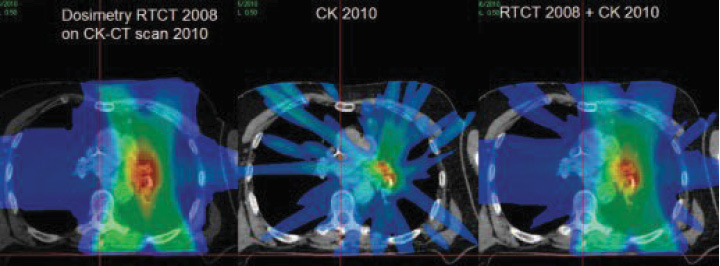Streszczenie
Rak płuca pozostaje główną przyczyną zgonów w 2012 r. w Unii Europejskiej. Chociaż leczenie operacyjne pozostaje dla raka płuca nadal leczeniem z wyboru, wciąż duża grupa pacjentów nie może być do niego zakwalifikowana. Radioterapia raka płuca wymaga natomiast podejścia innowacyjnego. Zdolność systemu stereotaktycznej radioterapii CyberKnife® do śledzenia i automatycznej korekcji ruchów oddechowych umożliwia eskalację dawek promieniowania, dając szansę na zwiększenie skuteczności leczenia. W niniejszym artykule przedstawiono ogólny zarys tej technologii oraz korzyści kliniczne, jakich dostarcza jako efektywna i bezpieczna metoda w leczeniu raka płuca, zarówno guzów pierwotnych i we wczesnej fazie zaawansowania, jak i przerzutów oraz wznów, w położeniach obwodowych i centralnych.
Słowa kluczowe: rak płuca, pozaczaszkowa radioterapia stereotaktyczna (SBRT), system CyberKnife®, ruchome obszary tarczowe, system śledzenia Synchrony®, rak płuca we wczesnej fazie zaawansowania, obwodowy guz płuca, centralny guz płuca, powtórne napromienienie
Abstract
Lung cancer remains in 2012 the leading cause of cancer-related deaths within the european union. Although surgery still constitutes the standard treatment for lung cancer, it is not feasible for a large number of patients. Treatment of lung tumours thus requires an innovative treatment solution. The ability of the CyberKnife ® stereotactic radiotherapy system to track and automatically correct for respiratory motion allows an increase of the radiation dose, and thus gives the opportunity to improve the efficacy of the treatment. in this article, an overview of this technology and its clinical benefits is provided and shows that it can offer an effective and safe option in the treatment of lung tumours, whether they are primary and early-stage, recurrent or secondary, as well as peripheral or central.
Key words: Lung c ancer, s tereotactic b ody r adiation therapy (sBrT), cyberKnife® system, mobile targets, synchrony® tracking system, early-stage lung cancer, peripheral lung tumour, central lung tumour, re-irradiation
Cały artykuł dostępny w wersji elektronicznej Flippingbook – Inżynier i Fizyk Medyczny 2/2012: www.inzynier-medyczny.pl
Joost J. Nuyttens¹, Pierre-Y ves Bondiau²
1 Department of Radiation Oncology, Erasmus MC-Daniel den Hoed Cancer Center, Postbus 2040–3000 CA, Rotterdam, The Netherlands, e-mail: j.nuyttens@erasmusmc.nl
2 Centre Antoine-Lacassagne, Nice, France


